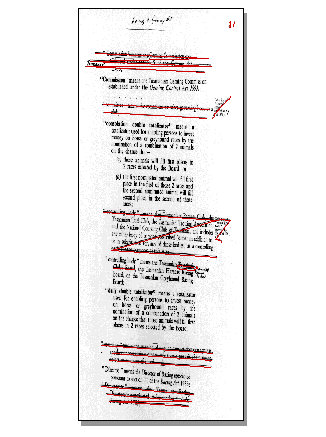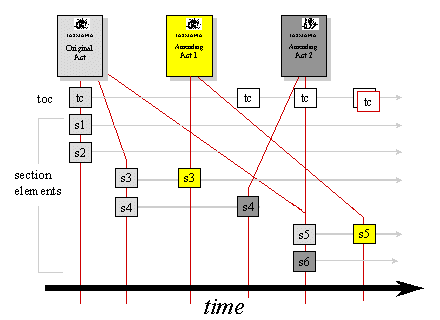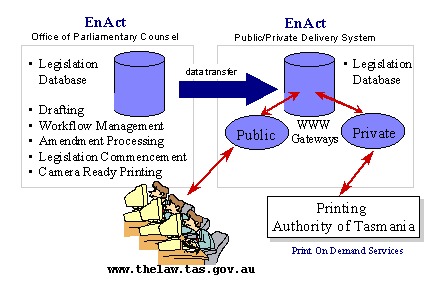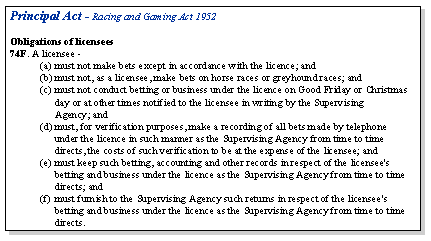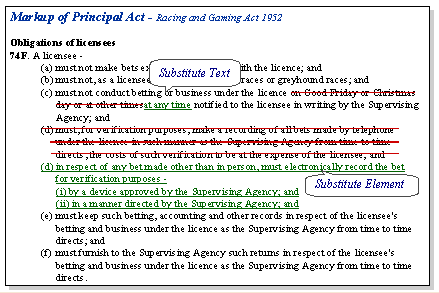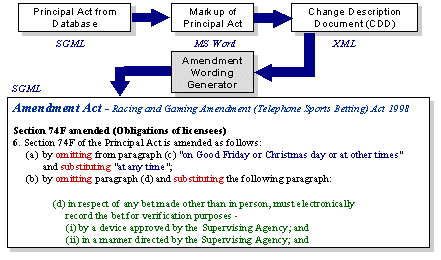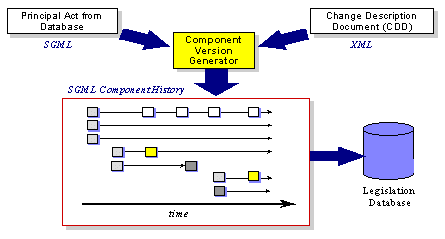JILT 2000 (1) - Arnold-Moore & Clemes
Figure 1: Example unofficial consolidation. 1.2 Desired out comes for Tasmania Clearly this situation was not satisfactory. In a legal environment where ignorance of the law is no excuse, it is unjust for the government to require compliance to the law where they cannot provide an adequate record of the text of that law. Recognizing this responsibility, and its past failure in this respect, the Tasmanian government initiated a project to address these problems and provide their citizens with quality access to legislation. The first priority was to make sure that the OPC and PAT were capable of meeting their obligations to provide timely publication of Bills before Parliament and Acts and Statutory Rules as enacted. At the same time, the desire was to make more timely availability of consolidations, in printed and electronic form. Initially this was envisaged as being in CD-ROM form but, as the project progressed, it became clear that the World Wide Web was also an important delivery option. Another desirable outcome for Tasmania was to improve access to Tasmanian legislation. Now, the most obvious way to do this is to provide free public access via the World Wide Web, although this was less clear in 1992 when the project was initiated. Web delivery improves access in a number of ways. In Tasmania at the end of 1998, 10% of households had Internet access[ 4 ]. Approximately 20% of Australian adults accessed the Internet at some time during 1998[ 5 ] and, since most schools and universities in Australia provide access to students, this figure is sure to be higher for younger Australians. Most public libraries in Australia also provide free access to the Internet. By making legislation available on the Web in addition to the traditional paper-based service, legislation is readily available to a whole new audience. Web delivery of legislation also provides better access for those with disabilities. For those who have mobility problems, either through temporary illness or permanent disability, or the elderly, they can now access legislation in their own homes, rather than having to mail-order expensive and heavy paper copies or visit libraries with public access. Paper-based publications are also inappropriate for the sight impaired. By using Braille teletype machines or even voice synthesis, the electronic text of the legislation is more accessible. The cost of this duplicated effort of maintaining legislation repositories is very difficult to measure but it is clearly substantial. The OPC seemed the logical place to concentrate the effort because this was the origin of the legislative material. Since the OPC also needed to maintain consolidations, it made sense to combine the responsibility for creating new legislation with the responsibility for maintaining consolidations that were of sufficient quality that all users of legislation could share them. Rather than simply providing the public with the legislation as enacted, ideally the new system would provide access to timely consolidations. This would mean the elimination of paste-ups altogether bringing great savings to all users of legislation who had to maintain their own consolidations. Another important outcome of the proposed project was to improve the effectiveness and standing of the law and the Parliament. If it was hard for the legal community and the citizens to get an accurate view of the current law, it was also hard for the Parliament. Since the vast majority of legislation considered is amending legislation, it is vital to the Parliament to have access to up-to-date consolidations in order to see how proposed amendments change the existing law. The democratic process is also better served by broad community access to current legislation so that any affected groups can lobby their representatives appropriately. All of these outcomes were sufficiently desirable to the Tasmanian people, that the Tasmanian government committed the considerable resources needed to a project to deliver all of these outcomes. The Legislation Systems Project began in 1992. Funding for the project was established with the following out puts to be delivered. The first requirement was to develop and implement technology for drafting, managing and delivering legislation. This part of the project was put to tender and RMIT together with Ferntree Computer Corporation[ 6 ] were successful in the tender and produced the EnAct system. This included the public face of EnAct?the authorized public web site[ 7 ]?and also the drafting system behind the scenes. The more hidden side of EnAct was a system for the OPC to produce Bills and other documents for Parliament, and to populate and maintain the repository of legislation to which the public Web site gives access. In order for this new system to be useful, the Tasmanian Statute Book needed to be consolidated in SGML form. This required a team of dedicated people sifting through the official and unofficial consolidations and keying them into SGML form, applying any intervening amendments as they went. An extensive, three stage proofreading regime was applied to these outputs so that the OPC could be confident that the electronic repository was correct. Since the Tasmanian legislation production process was still based on paper technology with few of the drafters even using a computer, an extensive business process re-engineering process was required. The re-engineering effort was managed by the Corporate Information Projects Unit (now Whole of Government Projects Unit) to assist the technology-na?ve OPC in dealing with the information technology providers and to provide strategies for managing the extensive change required as a result of implementing such a project. During re-engineering the new processes were captured in a workflow tracking system that forms part of EnAct. Another outcome of this project was to provide legislation to establish the database as the authorized version of legislation. The Legislation Publication Act 1997 [ 8 ] provides for the electronic repository maintained by the OPC to be the official authorized version of the legislation. It gives considerable power to the Chief Parliamentary Counsel to maintain that repository and to publish authorized versions of legislation. This unprecedented step illustrates the confidence that the Tasmanian government had in the consolidation process and the EnAct system. At the time of writing Tasmania was still the only known jurisdiction to make the electronic repository normative. 2. What makes legislation different? Legislation in Tasmania is similar in many ways to the legislation of the UK and most other jurisdictions that are former British colonies including other Australian jurisdictions, Canada and its provinces, and the United States. All Acts are divided into numbered sections (subordinate legislation variously calls these rules, regulations or clauses but the concept is the same). In larger Acts, these sections are grouped into numbered Chapters, Parts, Divisions, and Subdivisions. Each of these components has a heading, headnote or sidenote. Sections are further broken down into subsections, definitions, paragraphs, subparagraphs and other more specialized components. In traditional paper publications, this structure is represented by typographic conventions. The headings of higher level components are in larger fonts and a mixture of bold and italic. Section headnotes are typically bold. Lower level elements are distinguished by a combination of multiple levels of indentation, and numbering conventions. Section numbers are typically in Arabic, subsection numbers in bracketed Arabic, paragraph delimiters in bracketed lower-case alphabetic, and subparagraph delimiters in bracketed lower-case Roman. Electronic delivery tools such as older subscriber dial-in services and even newer Web services have not been particularly faithful in reproducing this typographic information to the user, thereby obfuscating the structure present and devaluing the status of these electronic services. For widespread acceptance in the legal community, this structure must be supported. Each of these sections is a logical unit that stands on its own but is related to other parts of the Act. There are extensive networks of cross-references between sections within an Act and also to components in other Acts. These can either be explicit text like 'section 35(2) of this Act' or be more implicit like an occurrence of a defined term[ 9 ]. Individual documents can contain as few as four sections or more than a thousand. This means that whole documents can be very large. The Stamp Duties Act 1931(Tas) is almost 1Mb of text, and the Income Tax Assessment Act 1936 (Cth) is almost 50Mb of text. For on-line viewing, these large documents must be broken down into manageable units without sacrificing the important context information of the surrounding text. Since all Acts contain sections, this provides a logical unit at which to fragment large documents. By displaying a table of contents along with the fragment, important context information remains available to a user. While this fragmentation approach contrasts the traditional delivery by the government printer of whole Acts, users of an electronic delivery system may also wish to print the whole Act rather than one fragment at a time. The way around this contrast is to store legislation in a format that allows the logical structure of the document to be represented so that all of the typographic elements can be reproduced and fragments can be easily extracted for on-line delivery. SGML[ 10 ] is an international standard that supports the representation of logical structure. It is widely used in the legal publishing field because of its suitability for legislation and complex legal commentary. Other advantages of SGML include the longevity of the data[ 11 ], vendor independent tool sets[ 12 ], the ability to validate the structure of each document against drafting standards[ 13 ], and the separation of the creation of content from the presentation of that content[ 14 ]. SGML was the required encoding standard in the original Request for Tender for a legislation management system. By using SGML, Tasmania is able to automate the fragmentation of an Act, or the joining of a table of contents and set of fragments back into a single Act. This allows documents to be stored either whole or as fragments depending on retrieval requirements of the relevant legislative process stage. 2.2 Changing over time and the need to retain old versions The most notable distinction of legislation, other than its complex structure, is that it varies with time. As discussed above, amendment legislation describes changes to the text of one or more Principal Acts. Either the amendments of the substantive law can be specified to commence at some time in the future or in the past. Amendments can apply before the substantive Act commences. They can expire reverting to the wording before the change was applied.
Figure 2: Example time-line of legislation. Figure 2 shows a time-line for a particular piece of legislation. An original Act commences sections 1 and 2 on an initial date, sections 3 and 4 on a later date, and section 5 on an even later date. After section 3 and 4 commence but before section 5, Amending Act 1 changes the text of section 3, and on a date after section 5 commences, substitutes a new section 5. The Amending Act 2 performs a retrospective amendment, repealing section 4 before Amending Act 2 actually commences. It also inserts a new section 6 at the same time section 5 commences. This time line shows each of the fragments and the table of contents and the lifetime for which each of these is valid. The first table of contents is not invalidated by a small textual change in section 3. A repeal, substitution, or insertion of a new section requires the table of contents to be updated. 2.3 User requirements ? 'point-in-time' access to legislation With these desired outcomes and these distinct properties of legislation in mind, it is important to design a user interface that supports these properties in ways that help users achieve their desired goals. Users require a variety of access methods to legislation. While paste-ups and printed consolidations provide the current text of an Act, that does not solve the whole problem. The Renton Committee[ 15 ], when considering the needs for maintaining UK legislation as early as 1975, discussed the possibility of storing a complete historical record of the legislation as an alternative to the common method of simply maintaining the current version. Despite Canada's decision to use only the current file, they supported the historical file (back to the last complete consolidation) as the preferred option. Campbell and McGurk[ 16 ] discuss the use of an information retrieval database of consolidations within a drafting office in 1987. These sources clearly indicate a need for keeping track of past versions of legislation. There are two reasons for this. The first and primary reason is that legal researchers need to know what the law was at particular points in the past[ 17 ]. A case goes before a court often many years after the relevant events took place but the court generally must apply the law at the time the disputed events took place, not the current law. Even when the current law is being applied, previous versions of the law may still be relevant: Exclusive reliance upon the reprint of regulations as amended ? sometimes, in a matter of interpretation, deprives the court of the advantage of seeing how the regulations were developed by amendment and why the amendments were made. ? It is not often that there is either need of or advantage in looking at the more authentic materials from which the Government Printer has reconstructed his convenient and perhaps more intelligible text. But this case happens, I think, to be such a one[ 18 ]. While it is extremely unwieldy to provide access to every previous version of a particular piece of legislation in paper form, electronic delivery can solve the storage and presentation problems. What users want is the ability to specify a time point and then search and browse the collection as it was at that time point, viewing the law that applied at that time. While it is helpful to search the current time point and browse to previous versions, being able to search previous versions is particularly important where provisions have been repealed or replaced by provisions that cover different ground. Since legislative documents are frequently very large, on-line retrieval needs to present fragments to the viewer[ 19 ]. Care must be taken to preserve information about the context of the fragments and allow the user to navigate to related fragments with ease. In a hypertext environment like the Web, cross-references should all be activated as hypertext links[ 20 ]. Where these links are to legislation, they should be to the legislation as it was at the same time as the time point of the legislation being viewed currently. It is also helpful, particularly for tracking changes in legislation to have history notes showing when the amendments were made and what Act effected them. Where these notes appear, it is desirable that they be linked to the actual amendment wording via hypertext. Many legal practitioners (particularly OPC drafters) will be intimately familiar with the legislation collection or certain parts of it and require the ability to navigate straight to a known section of an Act[ 21 ]. The search interface must allow search by Act number and year as well as title, and allow easy navigation to a known section. The browser interface must display a list of Act titles for the user to select the appropriate Act. While on-line browsing demands access to individual fragments, a user that wants to print the whole Act does not want to navigate to each fragment in turn and print them separately. Even if the Web repository is not an authorized version, it is desirable to allow the user to download a whole Act so that it can be printed as a single unit. 3. How does EnAct fulfil these requirements? The EnAct repository makes use of the Structured Information Manager to store SGML fragments and associated metadata directly. Acts are stored in SIM as fragments with a timestamp marking the time interval (start and end time) over which the fragment or table of contents is valid. The SIM repository incorporates an SGML parser allowing sophisticated indexing based on the logical structure of the SGML fragments. Time point searching is also supported. When a time point is specified, a filter is applied to the database leaving only those fragments and tables of content that were valid at the specified time. This allows a snapshot of the database to be searched and browsed as if it were the entire database. The SIM web server uses the same SGML parser. This allows HTML to be generated dynamically from the fragment repository for delivering Web pages. This means that the same repository can be viewed in a number of different ways. In the current public site one can view a fragment with or without history notes. A single fragment can be viewed on one side with a table of contents on the other, or with the table of contents and all of the fragments united together into a single document. All cross-references are activated as hypertext links. Because all hypertext links are activated using queries in the database, it is just as easy to do reverse hypertext links?i.e. show a list of all fragments that refer to this fragment or this Act. When history notes are displayed, those that refer to amending Acts on the system are also hypertext links to those Acts. The table of contents can be viewed either as a conventional section number and headnote or with a section number and list of links to successive versions of the corresponding fragments. This provides a quick overview of the history of a provision. A new feature is a previous and next version button for each fragment. In addition to the public web site, which delivers HTML to user's browsers, the Printing Authority of Tasmania also uses the same repository to generate 'on-demand' authorized reprints. A member of the public can contact the PAT shop and request a reprint of a particular Act on a specified day. They search the repository to find the relevant table of contents and fragments at that time point, which are joined together into a single SGML document that is translated into Rich Text Format using SIM formatters. This RTF representation is then passed to high-speed printers for paper output. Each authorized version is preceded by a certificate of authenticity from the Chief Parliamentary Counsel.
Figure 3: The EnAct repositories and how they are accessed At the end of the document two tables appear. The first shows the name and the time of commencement of all amending Acts applied to that Act since it was enacted. The second lists each provision that has been amended and how it was amended. The database that is shared by the public Web gateway and the private Printing Authority gateway is not the only repository in the EnAct system. A working database is also kept in the OPC. This database contains everything in the public repository, but also contains the politically sensitive draft Bills in preparation, and all of the workflow information about the status of Bills and other draft legislation. Data is periodically migrated from the production database to the publication database providing a level of protection from intrusion and preserving the integrity of the data on the public repository. 3.3 Behind the scenes ? the drafting environment In the past, any consolidation has been a laborious manual process. Drafters or clerical staff were required to sit down with the text of an Amending Act and go through it, section by section, applying each amendment to one or more Principal Acts. In the past drafters composed amending legislation directly, combining the process of deriving the effect of the amendments with the text describing them. The Tasmanian government presented RMIT with a different approach. The drafters would mark amendments directly on a consolidation of the Principal using strike-through and underline markings familiar to many lawyers. Amendment wordings for those markings would then be generated automatically. For example, to draft an amendment to section 74F of the Racing and Gaming Act 1952 , a drafter would check out the appropriate version of the Act from the repository as in Figure 4. Then each change would be marked on this version using strike through and underline giving a version like that in Figure 5.
Figure 4: Example section. These markings are then captured in an internal (SGML) representation of the changes called a Change Description Document (CDD). These changes are then used to generate amendment wordings, which are appended to a stub or substantive Bill as in Figure 6[ 22 ]. This process is managed by a workflow enactment service that keeps the CDD and generated amendments together so that, if and when the amendment Act commences, the amendments can then be automatically applied to the principle to generate new fragments in the historical repository[ 23 ].
Figure 5: The same fragment with amendments applied. Because we see structured documents all the time, we are used to inferring structure from typographic cues in the printed page. Largely these cues can be reproduced in electronic forms[ 24 ]. However, there is little paper-based precedent for representing multiple versions of a single document or part of a document. RMIT in collaboration with the Tasmanian government are working on ways of visualizing the temporal information contained within the EnAct repository, seeking ways of improving the interface and making the most of the information that has already been captured.
Figure 6: Using the CDD to generate amendment wording.
Figure 7: Using the CDD to generate fragments in the repository. In addition to the automatic generation of amendment wording, techniques have been devised to automate the understanding of amendment text, generating CDD's from amending Acts[ 25 ]. The incorporation of these techniques into EnAct would enable the simplification of business processes to support the amendment of amending Acts, and the production of Parliamentary amendments (amendments proposed for debate in Parliament). Work is currently being undertaken to develop a Web-based workflow enactment service and document management system using the Structured Information Manager as the basis of the repository. This would enable the EnAct workflow system to be moved away from a custom 'thick' client to a 'thin' Web client. This facilitates the movement of workflow tasks outside of the OPC, to Parliamentary Clerks and Cabinet Secretaries, who have no drafting responsibilities but can record changes in status of Bills as they happen. The lessons learned in the Tasmanian context and the solutions developed here are applicable to other jurisdictions. We are constantly working to implement this technology more widely and assist other jurisdictions to satisfy their public duty obligations to provide the highest quality of access to legislation that is reasonably possible. If a jurisdiction as small as Tasmania can provide such a service, how much more so can larger jurisdictions with considerably greater resources fund similar projects. The Tasmanian government is leading the world in taking up its responsibilities to provide public access to legislation. We have put considerable effort into understanding the distinct properties of legislation and meeting the needs of the users of legislation. By centralizing the responsibility for maintaining consolidations, we have eliminated re-keying and saved business and government considerable costs in maintaining their own consolidations. By locating that responsibility in the same office that drafts new legislation, we have enabled unprecedented automation of the drafting of legislation and its consolidation. Because the consolidation is automated, any delay in applying amendments to up-date the repository can be eliminated. Innovative use of the Internet has delivered a service far beyond what was possible with paper-only publication. Footnotes 1 . Tapper (1970) 'Computers and legislation' 23 Alabama Law Review 1-42. 2 . For more detail about different amendment strategies and generally about the EnAct system and associated research see Arnold-Moore (1998) Information Systems for Legislation , Ph. D. Thesis, RMIT. 3 . Editorial (1990) 'Textual amendment' 11 Statute Law Review iii-iv. 4 . Australian Bureau of Statistics . 5 . Australian Bureau of Statistics . 6 . In 1996, Ferntree Computer Corporation < http://www.ferntree.com.au/> was bought by GE Capital Information Technology Solutions and the focus of their business moved away from document technology. EnAct and the underlying Structured Information Manager is now being marketed in Australia through Aspect Computing < http://www.aspect.com.au/Aspect/Products/products_sim.html > and < http://www.simdb.com/>. 7 . http://www.thelaw.tas.gov.au/ 8 . http://www.thelaw.tas.gov.au/summarize/s/1/?ACTTITLE=%22LEGISLATION% 9 . The AustLII collection captures these as hypertext links at the moment, but EnAct does not at present because AustLII automates this process and, although very helpful, such automation can misrepresent the scope of definitions where they are limited to particular components. Because EnAct is the authorized repository, such errors of scope cannot be permitted. 10 . International Organization for Standardization. (1986) Information processing ? text and office systems ? Standard Generalized Markup Language (SGML) ISO/IEC 8879:1986. The newer Web standard, XML, which is a simplified subset of SGML, provides similar benefits although it was not available at the beginning of this project: World Wide Web Consortium. Extensible Markup Language (XML) 1.0 , W3C Recommendation, 1998; Bosak and Bray (1999) 'XML and the Second-Generation Web' 280 Scientific American 89-93. 11 . 'As an international standard, SGML ? is forced to be very stable. International standards are not changed whimsically. No single company or organization owns it and can steer it to their own advantage. Since SGML is so stable, software developers can safely build tools that employ the standard without the risk of having to constantly keep up with another company's dictums.' Travis and Waldt (1995) The SGML Implementation Guide: A Blueprint for SGML Migration . 12 . 'Users benefit from tools that work in predictable ways and can use off-the-shelf tools instead of having to develop their own validation and transformation programs.' ibid. 13 . Arnold-Moore (1998) Information Systems for Legislation Ph.D. Thesis, Royal Melbourne Institute of Technology. 14 . Barron (1989) 'Why use SGML?' 2 Electronic Publishing ? Origination, Dissemination and Design 3-24. 15 . The Preparation of Legislation (The Renton Report). Cmnd 6053, 1975. 16 . Campbell and McGurk (1987) 'Revising statutes with computer support' 8 Statute Law Review 104. 17 . Greenleaf et al (1995) 'Public access to law via Internet: the Australian Legal Information Institute' 6 Journal of Law and Information Science and Robertson and Merrick. (1994) 'Proposal for participation in the Workshop on Hypertext Systems and Version Support' in Durand et al Proceedings of the Workshop on Versioning in Hypertext Systems, pp. 35-38. 18 . O'Neill v. O'Connell (1946) 72 CLR 101, 122 per Dixon J < http://www.austlii.edu.au/au/cases/cth/high_ct/72clr101.html > 19 . This can also improve retrieval performance, see Arnold-Moore (1998) Information Systems for Legislation , Ph.D. Thesis, RMIT. 20 . Corbett (1992) 'Indexing and searching statutory text' 84 Law Library Journal 759-67; Hoey (1988) 'The discourse properties of the criminal statue' in Walter (ed) Computer Power and Legal Language ; and Schweighofer and Scheithauer (1996) 'The automatic generation of hypertext links in legal documents' in Wagner and Thoma (eds) Database and Expert Systems (DEXA'96). 21 . Tapper (1970) 'Computers and legislation' 23 Alabama Law Review 1-42. 22 . This process is described in greater detail in Arnold-Moore (1997) 'Automatic generation of amendment legislation' in Proceedings of the International Conference of Artificial Intelligence and Law (ICAIL'97). 23 . More detail on the workflow enactment aspect of the system can be found in Arnold-Moore (1998) Information Systems for Legislation Ph.D. Thesis, RMIT. 24 . Bosak and Bray (1999) 'XML and the Second-Generation Web' 280 Scientific American 89-93. 25 . Arnold-Moore (1995) 'Automatically processing amendments to legislation' in Proceedings of the International Conference of Artificial Intelligence and Law (ICAIL'95). Arnold-Moore T ,'Automatically processing amendments to legislation' (1995) in Proceedings of the International Conference of Artificial Intelligence and Law (ICAIL'95). Arnold-Moore T ,.'Automatic generation of amendment legislation' (1997) in Proceedings of the International Conference of Artificial Intelligence and Law (ICAIL'97). Arnold-Moore T , Information Systems for Legislation, Ph.D. Thesis, RMIT, 1998. Australian Bureau of Statistics Press Release, 29 May 1999. Barron D , 'Why use SGML?' (1989) 2 Electronic Publishing ? Organization, Dissemination and Design 3-24. Bosak J and Bray T , 'XML and the Second-Generation Web' (1999) 280 Scientific American 89-93 < http://www.sciam.com/1999/0599issue/0599bosak.html >. Campbell C and McGurk J , 'Revising statutes with computer support' (1987) 8 Statute Law Review 104. Corbett M , 'Indexing and searching statutory text' (1992) 84 Law Library Journal 759-67. Greenleaf G et al , 'Public access to law via Internet: the Australian Legal Information Institute' (1995) 6 Journal of Law and Information Science < http://www.austlii.edu.au/austlii/libs_paper.html >. Hoey M , 'The discourse properties of the criminal statue'(1988) in Walter (ed) Computer Power and Legal Language. International Organization for Standardization , Information processing ? text and office systems ? Standard Generalized Markup Language (SGML) ISO/IEC 9979:1986. Robertson J and Merrick F , 'Proposal for participation in the Workshop on Hypertext Systems and Version Support' (1994) in Durand et al Proceedings of the Workshop on Versioning in Hypertext Systems, 35-38. <ftp://bush.cs.tamu.edu/echt/vers-wkshp/VWReport.A4.ps.gz>. Schweighofer E, and Scheithauer D , 'The automatic generation of hypertext links in legal documents' (1996) in Wagner and Thoma (eds) Database and Expert Systems (DEXA'96). Tapper C , 'Computers and Legislation' (1970) 23 Alabama Law Review 1-42. Travis B and Waldt D , The SGML Implementation Guide, 1995. World Wide Web Consortium , Extensible Markup Language (XML) 1.0, W3C Recommendation, 1998 < http://www.w3.org/TR/REC-xml >. Editorial , 'Textual amendment' (1990) 11 Statue Law Review iii-iv. U.K.Command Paper , The Preparation of Legislation (The Renton Report). Cmnd 6053, 1975. |
||||||||||||||||||||||||||||||||||||||||||||||||||||||||||||||||

